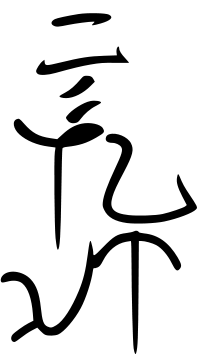Kulitan alphabet
Kulitan (also known as Culitan, Súlat Kapampángan, and Pamagkulit) is one of the various indigenous suyat[1] writing systems in the Philippines. It was used for writing Kapampangan, a language mainly spoken in Central Luzon, until it was succeeded by the usage of the Latin alphabet imposed by Spanish colonialists.
| Kulitan Pamagkulit, Súlat Kapampángan | |
|---|---|
 | |
| Type | |
| Languages | Kapampangan |
Time period | c. 1300–present |
Parent systems | Proto-Sinaitic alphabet
|
Sister systems | In the Philippines: Baybayin Buhid Hanunó'o Tagbanwa script In other countries: Balinese Batak Javanese Lontara Sundanese Rencong Rejang |
Kulitan is an abugida, or an alphasyllabary — a segmental writing system in wherein consonant–vowel sequences are written as a unit and possess an inherent vowel sound that can be altered with use of diacritical marks. The origins of Kulitan are uncertain. Although some believe it to be an indigenous invention, many of the symbols and writing rules of Kulitan resemble those of Kawi as well as the other Indian scripts of Southeast Asia. Usage of Kulitan has risen and declined many times, with main reasons for anti-propaganda and nationalism.[2]
There is a proposal to encode the script in Unicode by Anshuman Pandey, from the Department of Linguistics at UC Berkeley.[3] There are also proposals to revive the script by teaching it in Kapampangan-majority public and private schools.[1]
Modern Kulitan
Kulitan in Pampanga had already developed special shapes for four letters by the early 1600s, different from the ones used elsewhere. This ancient kapampangan script is very different from the experiment called "modern Kulitan" which was taught in the late 1990s. The ancient Kapampangan script used in the 1600s has been supplanted by a constructed script called "modern Kulitan."[4]
Structure
The indigenous characters were recorded as culit by the early 17th and 18th century Spanish lexicographers (Benavente, 1699 and Bergaño, 1732).[6] This served as inspiration for the name "Kulitan" which was recently coined to refer to the modern writing system. The ordinary folks simply called them Súlat Kapampángan to distinguish them from the Latin script.
Kulitan is basically made up of Indûng Súlat, or the "progenitor" (literally "mother") characters, and the Anak Súlat, or the "offspring" (literally "child") characters. The Indûng Súlat are the base characters with the unaltered inherent vowel sounds. They are the building blocks of Súlat Kapampángan. Indûng súlat gives birth to Anak Súlat or "offspring" characters whenever their inherent vowel sound has been altered by a ligature or a diacritical mark.
The siuálâ or vowels in Kulitan are usually written as garlit[7] or diacritical marks placed above or below an individual Indûng Súlat or "mother" character. Ligatures are also sometimes used to further lengthen these vowel sounds or represent the monophthongized diphthongs AI (E) and AU (O). A glyph with a diacritical mark or ligature attached to it is an Anak Súlat or "offspring" character. A consonant can lose its following vowel if written at the right side of the preceding consonant.
The recital order of the Indûng Súlat characters are A, I, U, E, O, GA, KA, NGA, TA, DA, NA, LA, SA, MA, PA, BA.[8]
Direction of writing
Historic:![]()
![]()
![]()
Kulitan is currently the only indigenous script in the Philippines that is written and read vertically from top to bottom and from right to left. In contrast, the Surat Mangyan, Hanunóo and Buhid scripts are written vertically from bottom to top and from left to right but read in any orientation.
Handwritten samples and signatures found in 17th century land deeds at the University of Santo Tomas Archives indicate that Kulitan was rarely written vertically,[9] but the written form may have changed during that particular period because of colonial influence. Historic catalogues of precolonial Filipino scripts point to a right-to-left and top-to-bottom writing direction, as with sister scripts of Tagalog and Tagbanwa.
See also
- Suyat
- Abugida
- Baybayin
- Tibetan alphabet
- Manchu alphabet
- Mongolian script
- Buhid script
- Hanunó'o script
- Tagbanwa alphabet
- Filipino orthography
- Kawi script
References
- Orejas, Tonette. "Protect all PH writing systems, heritage advocates urge Congress". newsinfo.inquirer.net.
- "Kulitan alphabet and Kapampangan language and prounciation". www.omniglot.com.
- Pandey, Anshuman (October 5, 2015). "Towards an encoding for Kulitan in Unicode" (PDF).
- "Christopher Ray Miller's answer to Is Baybayin really a writing system in the entire pre-hispanic Philippines? What's the basis for making it a national writing system if pre-hispanic kingdoms weren't homogenous? - Quora". www.quora.com.
- Bergaño, Diego (1732). "Vocabulario de Pampango en Romance y Diccionario de Romance en Pampango". Juan D. Nepomuceno Center for Kapampangan Studies & National Commission for Culture and the Arts, Philippines.
- Hilario, Zoilo (1962). "Bayung Sunis". Akademyang Kapampangan, Philippines.
- Pangilinan, Michael (2012). "An introduction to Kulitan, the indigenous Kapampangan script". Center for Kapampangan Studies, Philippines.
- Miller, Christopher Ray (2011). "Filipino Cultural Heritage in the UST Archives: Baybayin scripts in 17th century land deeds". University of Santo Tomas, Philippines.